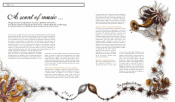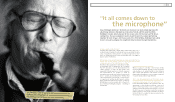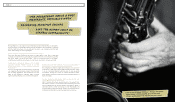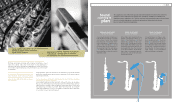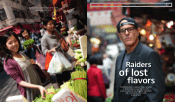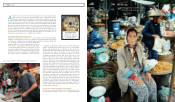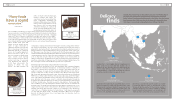Sennheiser 2010 Annual Report Download - page 11
Download and view the complete annual report
Please find page 11 of the 2010 Sennheiser annual report below. You can navigate through the pages in the report by either clicking on the pages listed below, or by using the keyword search tool below to find specific information within the annual report.
20 TREASURE HUNT 21
TREASURE HUNT
Delicacy
finds
Aromatic, flavorful and eye-catching culinary treasures. Found hiding deep in
the jungle, they are barked in colorful markets and prepared to perfection
in pots and pans. Food hunter Mark Brownstein scours Asia in search of ancient,
long-forgotten or local delicacies, then whisks them off to the world’s finest
chefs. Here, a treasure map detailing the locations of three of his finds.
2
KAI PEN
Luang Prabang / Laos
19° 53’ 52” north / 102° 9’ 39” east
Brownstein first tasted kai pen, paper-thin sheets of river
algae, in northern Laos, where it grows in the waters of the
Mekong and its tributaries. Strands of seaweed are laid out
in sheets and tenderized, strewn with sesame, garlic and
slices of tomato, and then cooked for a few seconds in hot,
but not too hot, vegetable oil (see page 20, above).
1
ELEPHANT-FRUIT
Udaipur / India
24° 37’ 3” north / 73° 53’ 45” east
Elephant-fruit or wood-apples (feronia elephantum). Its
name comes from its hard shell that allegedly only an
elephant can open. In former times, the elephant-fruit was
used to make delicious chutney; today it is an almost
forgotten delicacy – even in India. Brownstein discovered it
along the roadside in Udaipur (see page 18, above).
3
RUOU THOM
Hue / Vietnam
16° 23’ 59” north / 107° 40’ 58” east
Ruou thom, a spicy marinade used for poultry, was original-
ly devised by Emperor Tu Duc. In the imperial city Hué,
Vietnam, Brownstein searches for the six spices needed to
make the marinade. In vain, until he stumbles on Madame
Huy, whose great aunt was a palace cook. Succumbing to his
charm, she offers up the family recipe (see page 20, below).
1
2
3
with a craving for cumin, mustard seed,
turmeric, cinnamon and saffron. The
sounds we recorded are working their
magic, immediately stimulating my
brainstem. What amazes me is that the
effect is even stronger when I close my
eyes. Then it’s off to Laos and a whole
other world. Vientiane, its capital, looks
like an oversized village, which is irritat-
ing having just arrived from India. No
auto-rickshaws; no honking. It’s a quiet country. Flying north, we arrive in the moun-
tainous area home to Luang Prabang, the ancient imperial city situated on the Mekong
River. Background music. The soft gurgling of the great river. Upstream, a chugging
cargo boat. The food hunter is searching for kai pen, thin sheets of river algae –
Laotian edible paper – native to the waters of the Mekong and its tributaries. Using a
stock made from tamarind and sour jungle plum, the grass-green river algae is laid
out in strands and then gently slapped. In season, you can hear the patting every-
where. Sesame seeds, garlic and
tomato slices are strewn over the
sheets of algae. Brownstein is
taking the Mekong’s kai back with
him to Hong Kong’s finest hotels.
Wafer-thin, delicate, it is prepared
in Laos. As it is gently dipped into
the hot, but not too hot, oil of a
wok, you can hear its finely tuned
music. Sesame seeds bursting
open, moisture hissing as the kai
crackles and sings its epicurean
song. Brownstein has started to
record these nano-sounds. The
popping of Arborio rice near
Risotto; ant eggs bursting. By
studying his sound clips, Brownstein is better able to describe an ingredient’s individ-
ual character and texture to his select chefs. Brownstein and his film crew board a
plane back to Vietnam and back to the noise. We’re shooting a documentary series for
European television stations SWR and Arte. Hué is located in the center of the coun-
try. Wherever you go, the smell of coriander wafts from freshly prepared food. Our
soundtrack this time? Mopeds making their deliveries. Like flocks of geese, the masses
of mopeds weave in and out of each other, regroup and then, in an explosion of fumes,
zoom on. But there is more to Hué. It’s also the imperial city of Vietnam where its
emperors ruled until Ho Chi Minh arrived in 1945. Brownstein has been reading about
ruou thom, a marinade of fragrances used for chicken and painstakingly devised by
the “sad” emperor Tu Duc himself. We are in pursuit of its ingredients.
From the jungle to the tables of the world’s finest restaurants
The crowd is thick. Hard going for Alok, the cameraman. Only soundman Mathews
grins beneath his Sennheiser headphones. A Vietnamese market is a delight for
aficionados of the full stereo spectrum. It’s no wonder – the market offers up an
endless cacophony of sounds, and the Sennheiser MKH 416 takes it all in. That is,
except for fish. Rice noodles as they are being rolled. Dragon fruit being mixed.
CDs on sale bellowing their cheesy pop songs. And on the lead track, the Sennheiser
MKH 416 records the market women as they gossip, laugh, argue, paint their finger-
nails or get a perm. Sweating men as they carry their loads of merchandise, drink rice
wine and play cards. The noisy crowd is constantly being ploughed through by
mopeds as they make their deliveries of ducks or women with red-hot grills hanging
from their shoulder yokes. The grills are used to make bahn xeo (hissing pancake).
The soundman is preoccupied with the bountiful sounds. Not the food hunter. His
treasure is rare. The people have all heard about the emperor’s marinade, but it is no
longer sold. The recipe seems to have been lost. Brownstein continues his search for
Madame Huy, whose great aunt was a palace cook. Finding her at last, Brownstein
courts, flirts, coos. Madame Huy doesn’t stand a chance. “I will share the recipe with
you and with the whole world,” she finally surrenders. When the food hunter
presents his imperial treasure trove a few weeks later, his discerning chefs are
enchanted: “It’s a dream!”
KAI PEN
Wafer-thin sheets of
seasoned river algae – a traditional
snack in Laos
2
RUOU THOM
Toasted spices soaked in
rice wine for months are used
for the marinade.
3
“Many foods
have a sound
connotation.”
M A RK B R OW NS TE IN





